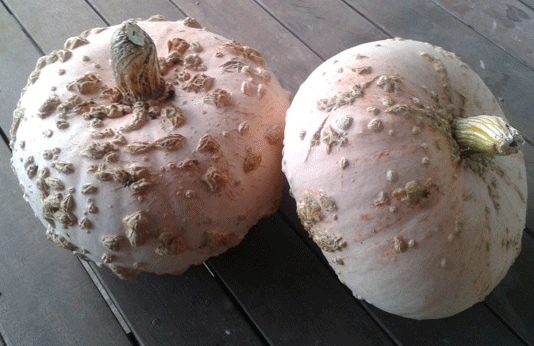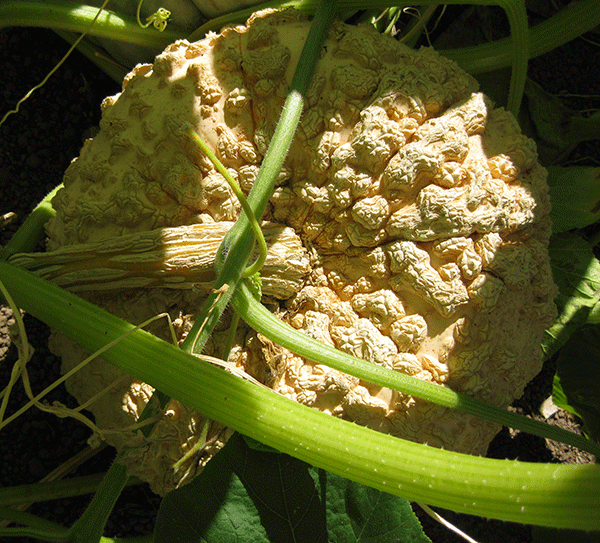A pumpkin like no other
One of my colleagues brought into the office the other day the pumpkin ‘Galeux D’Eysines’. Bringing in veges to the office is something we often do – sharing in the bounty – but this pumpkin, instead of being shared to eat has now been adopted and adored by all! It is considered way too beautiful to cut; the pumpkin now proudly sits on the front desk for all to wonder at and admire. In fact it even came to our Christmas Party. I’ve never seen a vegetable get so much attention.
Cucurbita maxima ‘Brode Galeux D’Eysines’ is an elegant French heirloom. It’s a large pumpkin, weighing in at 5-6 kg, with salmon-pink coloured skin. What’s particularly beautiful about it is that it is covered with peanut shell-like warts caused by sugar in the skin, as it ripens. Hence its name ‘Brode Galeux D’Eysines’. While sounding so romantic it actually translates to ’embroidered with warts from Eysines’. Any injury to the fruit’s skin will result in the formation of new warts as a protective covering. The GH team has carved their initials into the skin and each one is slowly forming new warts. Gorgeous.
Great for regions that are hot and humid, Galeux D’Eysines is easy to grow. The flesh is sweet, moist, orange and isn’t stringy, so it can be used for baking and makes delicious soups. It stores for up to 6 months and you know which one to pick first because – you guessed it – it will have the most warts!
Tags: vegetables
Posted in Organic Gardening





Can I buy these seeds off you guys as I would love to put some in my garden at the school where I am a groundsman.I thin k it would be a novelty for the kids.Regards Graeme.
These are definitely worth growing, you can buy seeds at http://greenharvest.com.au/SeedOrganic/VegetableSeeds/Pumpkin.html
but only for shipping within Australia
I have three questions please?
1. Do you think that this wonderful pumpkin has a place for sale in farmers markets?
2. Could this be grown on a trellis to make it easier for my back.
3. Do you know if the Cucumber fly would affect this if grown near Newcastle, NSW?
Is there any other variety of pumpkin that I could grow in the same area, not directly next to this one, and still have a pure strain of seeds?
Thanks again for an open and honest review of a really novel and delightful fruit.
Judging from the reaction of anyone first seeing this pumpkin, I’d say it would be a hit at farmers markets! The flavour and texture is very good too. I’ve seen the fruit get to a fair size – about 6kg and 30cm diameter – so a trellis would have to support that. It’s possible, but unlikely, that this pumpkin would be affected by cucumber fly in the Newcastle area. You might consider netting or bagging fruit to exclude the pests if they have been a problem previously. Galeux D’Eysines is a Cucurbita maxima, so to prevent cross-pollination, pumpkins grown in the same area at the same time should be Cucurbita moschata – eg ‘Buttercup’, ‘Violina’ or ‘Waltham Butternut’ or Cucurbita pepo – ‘Kumi kumi’ or ‘Pepita’.
Hey WoW… So as someone who hasn’t really saved seeds for developing a mini seed bank you have answered a question I’ve asked in several forums but not had any replies… So, a big thanks for the reply first and foremost.
To clarify if I need / want to grow different varieties of pumpkin / squash, then I need to be sure they are the same species; IE C. Pepo species and the varieties you mention such as … Pepita and delicata squash? Or say Golden Nugget and Jack Be Little, which are from the species C. Maxima…?
So, if I can build a trellis and successfully grow some of the larger pumpkins then I should photograph it and send it…LoL… I’ve seen 5kg pumpkins on trellis here in Europe. Coming home this October after being here for 17 years, I’m really looking forward to growing some things in warmth again.
If you have pumpkins from the same species – say two Cucurbita maxima like Galeux D’Eysine and Australian Butter – growing in the same area at the same time, they have the potential to cross-pollinate. That means that the pumpkins on these plants will grow as expected but the seeds they contain may produce plants that are a cross between the two original pumpkin types. So, no effect on the fruit but a possible effect on the next generation’s plants. Ensuring that you only plant a C. maxima at the same time as a C. moschata means that they can’t cross-pollinate, being different species. So, all going well, the seeds collected from your fruit should grow true to type.
Once again thank you so much … Got it this time. 🙂 if I want or need to grow the same species then vigilant, barrier ready, dawn and evening patrols are the order of the day. All this is only important if I am saving seed for my seed bank. If growing to use as food or forage then it’s all good either way. Protecting the fruits or leaving nature to do its thing.
Have you ever made pumpkin or gramma pie? If so, which variety did you use?
What other hull less varieties have the healthy seeds that help men’s issues please? i know of Pepita.